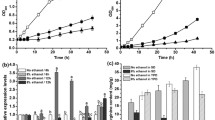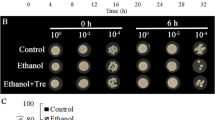Abstract
N-Acetyltransferase Mpr1 of Saccharomyces cerevisiae can reduce intracellular oxidation levels and protect yeast cells under oxidative stress, including H2O2, heat-shock, or freeze-thaw treatment. Unlike many antioxidant enzyme genes induced in response to oxidative stress, the MPR1 gene seems to be constitutively expressed in yeast cells. Based on a recent report that ethanol toxicity is correlated with the production of reactive oxygen species (ROS), we examined here the role of Mpr1 under ethanol stress conditions. The null mutant of the MPR1 and MPR2 genes showed hypersensitivity to ethanol stress, and the expression of the MPR1 gene conferred stress tolerance. We also found that yeast cells exhibited increased ROS levels during exposure to ethanol stress, and that Mpr1 protects yeast cells from ethanol stress by reducing intracellular ROS levels. When the MPR1 gene was overexpressed in antioxidant enzyme-deficient mutants, increased resistance to H2O2 or heat shock was observed in cells lacking the CTA1, CTT1, or GPX1 gene encoding catalase A, catalase T, or glutathione peroxidase, respectively. These results suggest that Mpr1 might compensate the function of enzymes that detoxify H2O2. Hence, Mpr1 has promising potential for the breeding of novel ethanol-tolerant yeast strains.





Similar content being viewed by others
References
Aguilera A, Benitez T (1985) Role of mitochondria in ethanol tolerance of Saccharomyces cerevisiae. Arch Microbiol 142:389–392
Alexandre H, Rousseaux I, Charpentier C (1994) Relationship between ethanol tolerance, lipid composition and plasma membrane fluidity in Saccharomyces cerevisiae and Kloeckera apiculata. FEMS Microbiol Lett 124:17–22
Buttner S, Eisenberg T, Herker E, Carmona-Gutierrez D, Kroemer G, Madeo F (2006) Why yeast cells can undergo apoptosis: death in times of peace, love, and war. J Cell Biol 175:521–525
Casey GP, Ingledew WM (1986) Ethanol tolerance in yeasts. Crit Rev Microbiol 13:219–280
Charizanis C, Juhnke H, Krems B, Entian KD (1999) The mitochondrial cytochrome c peroxidase Ccp1 of Saccharomyces cerevisiae is involved in conveying an oxidative stress signal to the transcription factor Pos9 (Skn7). Mol Gen Genet 262:437–447
Chi Z, Arneborg N (1999) Relationship between lipid composition, frequency of ethanol-induced respiratory deficient mutants, and ethanol tolerance in Saccharomyces cerevisiae. J Appl Microbiol 86:1047–1052
Costa V, Amorim MA, Reis E, Quintanilha A, Moradas-Ferreira P (1997) Mitochondrial superoxide dismutase is essential for ethanol tolerance of Saccharomyces cerevisiae in the post-diauxic phase. Microbiol 143:1649–1656
Davidson JF, Whyte B, Bissinger PH, Schiestl RH (1996) Oxidative stress is involved in heat-induced cell death in Saccharomyces cerevisiae. Proc Natl Acad Sci USA 93:5116–5121
Du X, Takagi H (2005) N-Acetyltransferase Mpr1 conferred freeze tolerance in Saccharomyces cerevisiae by reducing reactive oxygen species. J Biochem 138:391–397
Fowden L (1956) Azetidine-2-carboxylic acid: a new cyclic imino acid occurring in plants. Biochem J 64:323–332
Furukawa K, Kitano H, Mizoguchi H, Hara S (2004) Effect of cellular inositol content on ethanol tolerance of Saccharomyces cerevisiae in sake brewing. J Biosci Bioeng 98:107–113
Haliwell B, Gutteridge JM (1984) Oxygen toxicity, oxygen radicals, transition metals and disease. Biochem J 219:1–14
He XJ, Fassler JS (2005) Identification of novel Yap1p and Skn7p binding sites involved in the oxidative stress response of Saccharomyces cerevisiae. Mol Microbiol 58:1454–1467
Huh WK, Falvo JV, Gerke LC, Carroll AS, Howson RW, Weissman JS, O’Shea EK (2003) Global analysis of protein localization in budding yeast. Nature 425:686–691
Ibeas JI, Jimenez J (1997) Mitochondrial DNA loss caused by ethanol in Saccharomyces flor yeasts. Appl Environ Microbiol 63:7–12
Inoue Y, Matsuda T, Sugiyama K, Izawa S, Kimura A (1999) Genetic analysis of glutathione peroxidase in oxidative stress response of Saccharomyces cerevisiae. J Biol Chem 274:27002–27009
Inoue T, Iefuji H, Fuji T, Soga H, Satoh K (2000) Cloning and characterization of a gene complementing the mutation of an ethanol-sensitive mutant of sake yeast. Biosci Biotechnol Biochem 64:229–236
Jabs T (1999) Reactive oxygen intermediates as mediators of programmed cell death in plants and animals. Biochem Pharmacol 57:231–245
Jiang H, English AM (2006) Phenotypic analysis of the ccp1Δ and ccp1Δ-ccp1 W191F mutant strains of Saccharomyces cerevisiae indicates that cytochrome c peroxidase functions in oxidative-stress signaling. J Inorg Biochem 100:1996–2008
Kimura Y, Nakamori S, Takagi H (2002) Polymorphism of the MPR1 gene required for toxic proline analogue resistance in the Saccharomyces cerevisiae complex species. Yeast 19:1437–1445
Köhrer K, Domdey H (1991) Preparation of high molecular weight RNA. In: Guthrie C, Fink GR (eds) Methods enzymology, vol. 194. Academic, San Diego, pp 398–405
Kumar A, Agarwal S, Heyman JA, Matson S, Heidtman M, Piccirillo S, Umansky L, Drawid A, Jansen R, Liu Y, Cheung KH, Miller P, Gerstein M, Roeder GS, Snyder M (2002) Subcellular localization of the yeast proteome. Genes Dev 16:707–719
Lee SM, Park JW (1998) Thermosensitive phenotype of yeast mutant lacking thioredoxin peroxidase. Arch Biochem Biophys 359:99–106
Lee J, Godon C, Lagniel G, Spector D, Garin J, Labarre J, Toledano MB (1999) Yap1 and Skn7 control two specialized oxidative stress response regulons in yeast. J Biol Chem 274:16040–16046
Livak KJ, Schmittgen TD (2001) Analysis of relative gene expression data using real-time quantitative PCR and the \( 2^{{ - \Delta \Delta Ct}} \) method. Methods 25:402–408
Manfredini V, Martins VD, Peralba Mdo CR, Benfato MS (2005) Adaptative response to enhanced basal oxidative damage in sod mutants from Saccharomyces cerevisiae. Mol Cell Biochem 276:175–181
Mansure JJC, Panek AD, Crowe LM, Crowe JH (1994) Trehalose inhibits ethanol effects on intact yeast cells and liposomes. Biochim Biophys Acta 1191:309–316
Mishra P, Prasad R (1988) Role of phospholipid head groups in ethanol tolerance of Saccharomyces cerevisiae. J Gen Microbiol 134:3205–3211
Nestelbacher R, Laun P, Vondrakova D, Pichova A, Schuller C, Breitenbach M (2000) The influence of oxygen toxicity on yeast mother cell-specific aging. Exp Gerontol 35:63–70
Nomura M, Takagi H (2004) Role of the yeast novel acetyltransferase Mpr1 in oxidative stress: regulation of oxygen reactive species caused by a toxic proline catabolism intermediate. Proc Natl Acad Sci USA 101:12616–12621
Nomura M, Nakamori S, Takagi H (2003) Characterization of novel acetyltransferases found in the budding and fission yeasts that detoxifies a proline analogue, azetidine-2-carboxylic acid. J Biochem 133:67–74
O’Brien KM, Dirmeier R, Engle M, Poyton RO (2004) Mitochondrial protein oxidation in yeast mutants lacking manganese-(MnSOD) or copper- and zinc-containing superoxide dismutase (CuZnSOD): evidence that MnSOD and CuZnSOD have both unique and overlapping functions in protecting mitochondrial proteins from oxidative damage. J Biol Chem 279:51817–51827
Park JI, Grant CM, Attfield PA, Dawes IW (1997) The freeze-thaw stress response of the yeast Saccharomyces cerevisiae is growth phase specific and is controlled by nutritional state via the RAS-cyclic AMP signal transduction pathway. Appl Environ Microbiol 63:3818–3824
Peterson PJ, Fowden L (1963) Different specificities of proline-activating enzymes from some plant species. Nature 200:148–151
Piper PW (1995) The heat shock and ethanol stress responses of yeast exhibit extensive similarity and functional overlap. FEMS Microbiol Lett 134:121–127
Royall JA, Ischiropoulos H (1993) Evaluation of 2′,7′-dichlorofluorescin and dihydrorhodamine 123 as fluorescent probes for intracellular H2O2 in cultured endothelial cells. Arch Biochem Biophys 302:348–355
Shichiri M, Hoshikawa C, Nakamori S, Takagi H (2001) A novel acetyltranferase found in Saccharomyces cerevisiae Σ1278b that detoxifies a proline analogue, azetidine-2-carboxylic acid. J Biol Chem 276:41998–42002
Susani M, Zimniak P, Fessl F, Ruis H (1976) Localization of catalase A in vacuoles of Saccharomyces cerevisiae: evidence for the vacuolar nature of isolated “yeast peroxisomes”. Hoppe-Seyler Z Physiol Chem 357:961–970
Takagi H, Shichiri M, Takemura M, Mohri M, Nakamori S (2000) Saccharomyces cerevisiae Σ1278b has novel gene of the N-acetyltransferase gene superfamily required for l-proline analogue resistance. J Bacteriol 182:4249–4256
Takagi H, Takaoka M, Kawaguchi A, Kubo Y (2005) Effect of l-proline on sake brewing and ethanol stress in Saccharomyces cerevisiae. Appl Environ Microbiol 71:8656–8662
Tsuchiya M, Suematsu M, Suzuki H (1994) In vivo visualization of oxygen radical-dependent photoemission. Methods Enzymol 233:128–140
Wong CM, Zhou Y, Ng RW, Kung HF, Jin DY (2002) Cooperation of yeast peroxiredoxins Tsa1p and Tsa2p in the cellular defense against oxidative and nitrosative stress. J Biol Chem 277:5385–5394
Acknowledgment
We wish to thank M. Shichiri and M. Nomura (Fukui Prefectural University, Fukui, Japan) for assistance in the Northern analysis and H. Shimoi (National Research Institute of Brewing, Higashihiroshima, Japan) for the discussion on this work. We also thank G. Fink and C. Kaiser (Massachusetts Institute of Technology, Cambridge, MA) for providing yeast strains L5685 and CKY263, respectively. This work was supported by a grant for the Program for Promotion of Basic Research Activities for Innovative Biosciences (PROBRAIN) and by a grant-in-aid for the Scientific Research from the Ministry of Education, Culture, Sports, Science and Technology of Japan (18380062) to H.T.
Author information
Authors and Affiliations
Corresponding author
Rights and permissions
About this article
Cite this article
Du, X., Takagi, H. N-Acetyltransferase Mpr1 confers ethanol tolerance on Saccharomyces cerevisiae by reducing reactive oxygen species. Appl Microbiol Biotechnol 75, 1343–1351 (2007). https://doi.org/10.1007/s00253-007-0940-x
Received:
Revised:
Accepted:
Published:
Issue Date:
DOI: https://doi.org/10.1007/s00253-007-0940-x




